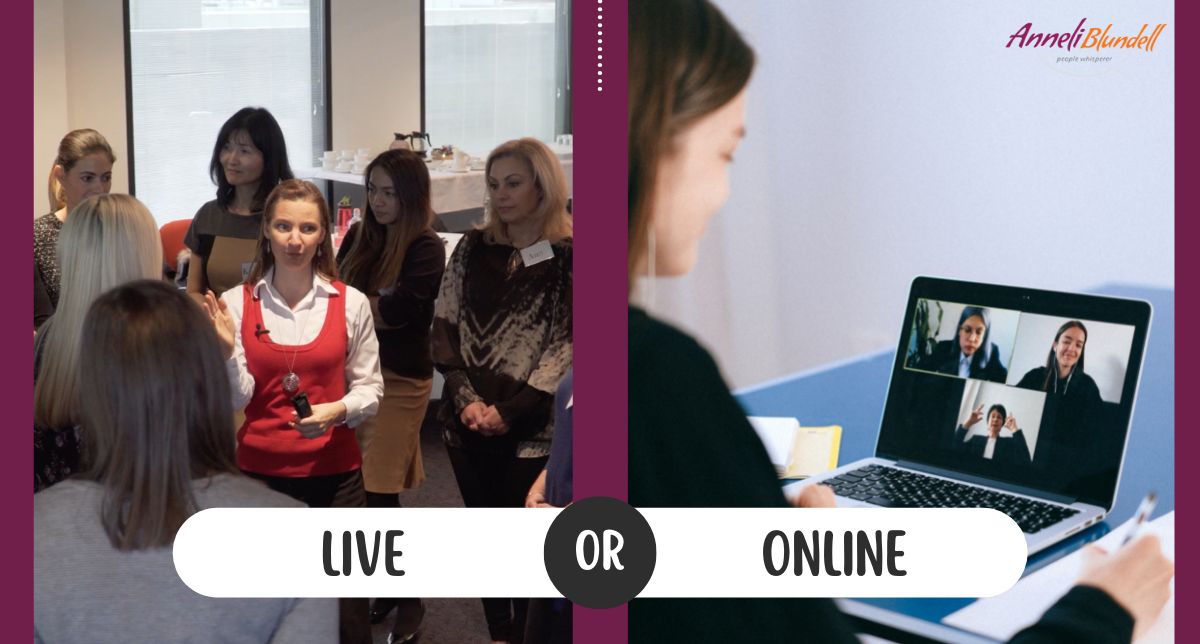Now we are back in the office (in some way, shape or form) we need to decide what comes back with us, and what stays on line. This is particularly important for training and development and team building. Over the last few years, we have proven that not only can we work remotely, we can also learn remotely.
So, should we go back to doing these things in person now that we can?
Yes, and no. It depends on your people, your purpose, and your purse strings. Let me explain…
Having run face to face workshops, trainings, and presentations for over 15 years, and seeing my clients achieve stellar results, I was firmly in the Yes camp… pre pandemic. How could you not be? The buzz. The magic. The energy. The live experience, in some contexts, is unparalleled.
However, now that I have delivered all of my work online for 2 years without a noticeable decrease in satisfaction or results, I am in both camps! And the value of having done both is that I now have a clear perspective of when to suggest online to my clients, and when to suggest face to face. In a nutshell, here’s what I recommend. Online is good for individual skill development, and face to face is good for group relationship development.
Online is good for a skills focus
Online works best for building new habits and skills sets for individuals, particularly at scale. You can train more people, from different locations, for a lower cost and still produce sustainable behaviour change. It is also more convenient for most people, is easier to schedule, and the results are nothing short of incredible. (Ask me about my Coaching skills for leaders’ program if you want an example. 🙂 )
In fact, research from the Neuroleadership institute has shown that there is greater learning transfer from online training programs that are short and spaced out, than there is for one-off, full day, classroom trainings. And we have known this for some time because it suits how the brain learns. When learning is spaced out over time, and provided in bite size pieces, it is easier for the brain to absorb, apply, reflect and repeat. This produces the most effective skill building outcomes. After all, all skill building is habit building, and habits don't form because you learnt some new information. They form when you understand, apply and reflect. Again and again and again.
Face to face is good for a relationship focus
On the other hand, face to face training is best for smaller groups, or intact teams, where the interpersonal dynamics either are the work or significantly affect the work. For example, groups that need to rumble with creative tension and productive conflict, or explore collaboration styles and personality clashes, get better results when in a contained space together. When the topic might produce ‘emotional heat’, it’s best to be in the same room.
As a facilitator in these conversations, I noticed the main difference is that I can more effectively read the room. I can see torso and feet positions (which is an unconscious reflection of who people feel more connected to or separate from). I can see who defers to whom; who supports whom; who people look to for validation and support; when the emotional temperature is getting too hot, and when the group is splitting. All of this is unavailable on line because we can’t observe people’s non-verbal cues in relation to others in the group.
In summary
Here are the questions to consider when deciding between face to face and online sessions:
How many people are involved? – large scale versus small group
Is the outcome about personal skills or interpersonal dynamics (e.g. abilities versus relationships)
How big is the budget? – what budget? 🙂 versus substantial budget
What behaviour change is expected? – actions versus attitudes
Of course, there are examples of live one-day training programs also producing incredible results (like my Women @Work Program - yep another shameless plug 🙂 ) and there are examples of online gatherings that deepen and strengthen relationships (like my conversation cafes and group coaching sessions), but as a general rule, the above maxim still stands – Online for skills development, and off line for relationship development.
I’d love to hear what you think.

